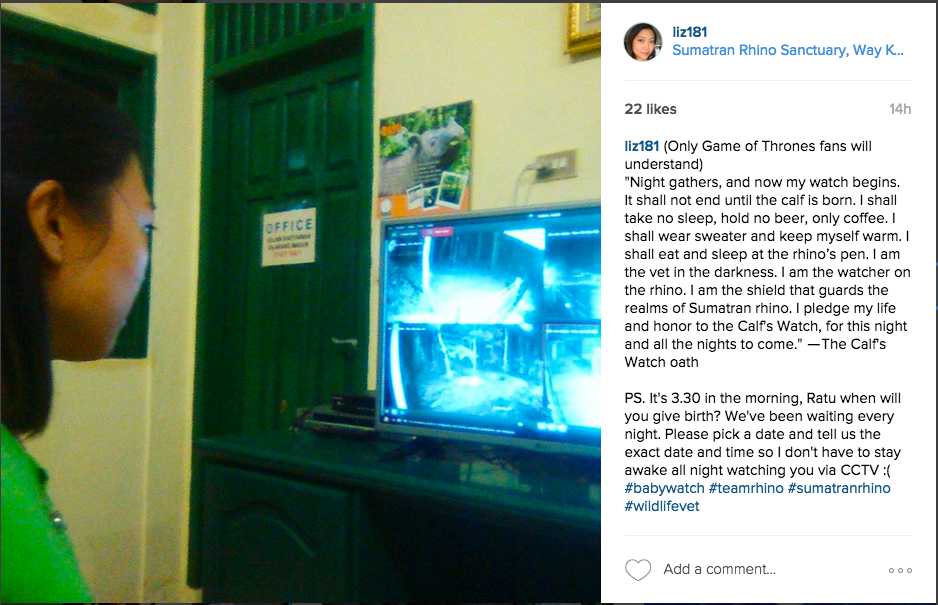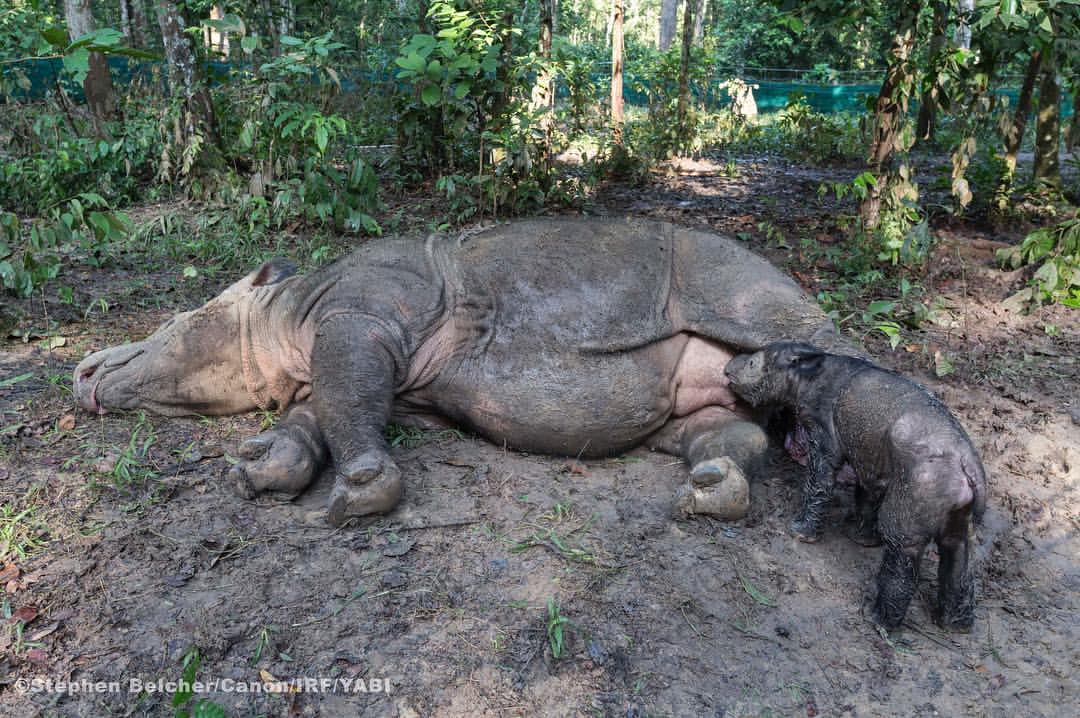“I hope it’s going to be tonight, or tomorrow night.”
That’s what I kept on telling people whenever they asked when Ratu, the pregnant Sumatran rhino, would give birth. Based on calculation from Ratu’s gestation period of Andatu (Ratu’s first calf), she was due last week but there was still no obvious sign of when she would deliver the calf, so all we could do was to wait and see, apart from ultrasound-ing her every few days.
We didn’t sleep well in the last week, worried that Ratu would give birth any night and I had spent some nights going to bed at 2 a.m and waking up at 6.30 a.m only to monitor her condition. However, last week I had a hunch that she would give birth later that night so I took a nap. It was also an educated guess because she showed some behavioral change. So I took a two-hour nap hoping to see a Sumatran rhino calf that night, but unfortunately the pregnant mother changed her mind and wanted to keep her baby inside for a little bit more. That night, I couldn’t sleep and stayed awake watching a rhino sleep soundly through the night. Tricky girl!
Days went by, she was getting more and more restless, and so were we! We were hoping every single day that the calf would be born that night. I communicated with her and did a couple of BodyTalk sessions, only to find out that she did not feel safe with bright lights surrounding her forested enclosure (there were a couple of floodlights installed). I tried to address this issue but some of the staff insisted that the lights were needed. A couple of BodyTalk sessions really calmed her down though, and addressed some of her stress resulted from human’s fear.
Then yesterday, I got another hunch. This one was merely a hunch and there was no educated guess. I successfully took a three-hour nap yesterday afternoon (a piece of cake if you haven’t had enough sleep in the last 6 days) and thought if Ratu was not going to give birth that night or the following morning, I’d spend another sleepless night watching her sleeping and wallowing in the mud – the last thing I wanted to do that night. Well, it was around midnight and Ratu seemed to be restless and sleeping less, so I thought that was a good sign … before she slept again and there was no sign of labor (again! She tricked me twice, that girl!). I waited and waited and waited for almost 3 hours, and she was still sleeping. I started feeling frustrated because of the floodlights, I did not know why but I guess that was a mirror of Ratu’s frustration that I felt. At 3 a.m I was getting sleepy and finally decided to give up, but before going to bed I uploaded a silly picture/status on my Instagram, showing how frustrated I am waiting for Ratu’s calf every night.

Just after the picture was uploaded, Ratu decided to wake up and walked around her enclosure. I decided to wait a little bit more, but she went behind a big tree and stayed there. It was dark (probably the darkest site where she could avoid the floodlights) and I could not see a thing. I was about to give up again when I heard report that her water broke and there were signs of first stage labor! I was so excited and all the sleepiness suddenly evaporated into thin air!
No words can describe how precious the moments are. From the moment when the calf’s hind legs emerged (it was posterior longitudinal presentation, video here), followed by her small body and head covered in hair, to the moment she started to stand up, fell, stood up again, until finally made her first few steps in this world!! Nature is incredibly amazing, especially when we see an animal birth, they just knew what to do from the very second they are born into this world, without being told or taught by anyone of what they should do. They just knew instinctively. Ratu did not touch her calf for the first couple of hours, and I guessed it was to encourage the calf to stand up and walk towards her to suckle. If she had approached the calf, the calf would not have tried to stand up and walk while it was vital for the calf to use her muscles immediately.

Within less than an hour, the calf really did her best at standing up on her four feet for the first time. It took her less than an an hour and a half to start taking small baby steps, and within 3 hours after birth she had already started suckling. It was funny to see her sniffing Ratu’s belly randomly searching for the teats, not sure where to locate them.
Kudos to the new vet team at Sumatran Rhino Sanctuary! Read more about the birth on IRF’s official press release here.

So adorable.
So amazing.
So priceless.
Thank you Mother Earth. I hope we, the minority of humans, can continue to preserve the nature while the majority of us are destroying it, even though we are all guilty for that.
PS. I haven’t slept all night as I’m typing this post. Forgive me for a boring-and-not-so-lively story and awful grammar, but I do hope you enjoy the story 🙂




